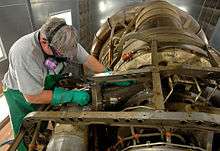Paul E. Garber Preservation, Restoration, and Storage Facility

The Paul E. Garber Preservation, Restoration, and Storage Facility is located in Suitland, Maryland, United States. The facility, also nicknamed "Silver Hill", is where the Smithsonian Institution's National Air and Space Museum restores aircraft, spacecraft, and other artifacts.
It is named in honor of Paul E. Garber, a Smithsonian curator who devoted most of his career to maintaining a collection of historic aircraft. It was created in the early 1950s by Garber to store, protect the museum's growing collection of World War II aircraft and provide space to restore them. The facility consists of 32 unassuming metal buildings. 19 of those buildings are devoted to storage of airplanes, spacecraft, engines, and various parts awaiting restoration. One building is devoted to a large restoration shop, and three buildings are for exhibition creation.
The restorers sometimes call on other Smithsonian professionals such as fine art painting restoration experts to consult on aircraft restoration projects. To date, the largest restoration project undertaken by the Garber Facility was the B-29 Superfortress, "Enola Gay". Work began in 1984. The fuselage alone took 10 years of work. The aircraft was finally delivered to the Steven F. Udvar-Hazy Center in 11 tractor trailer loads over the space of three months in 2003.[1]
Previously it acted as a storage facility for items which could not be put on public display, but with the completion of the Steven F. Udvar-Hazy Center, and restoration at its own, on-site Mary Baker Engen Restoration Hangar facility, all items in storage are being moved out of the Garber Facility. With the opening of Udvar-Hazy, the Garber facility was closed to public tours.
Approximately 65 space suits from the Mercury, Apollo, and other US space programs had been stored at the facility in an environmentally-controlled room.
The roof collapsed on the facility's Warehouse #21 just before dawn on February 10, 2010 during a blizzard and the region's second 15 to 30 inch snowstorm during a five-day period.[2] The warehouse, scheduled for eventual demolition after transfer of the artifacts to the Steven F. Udvar-Hazy Center, contained historic aircraft and spacecraft that were exposed to sub-freezing temperatures and blowing snow. They were not thought to be damaged, as all were in protective boxes or crates on shelving units that were still supporting parts of the warehouse.[3]
References
- ↑ Artifact Restoration — Enola Gay (aft fuselage), National Air and Space Museum, Smithsonian Institution, USA. Retrieved March 20, 2018.
- ↑ Prince George's County Fire Department report, February 10, 2010. Retrieved March 20, 2018.
- ↑ "Roof Collapse for "Nation's Attic"". CBS News. February 10, 2010. Retrieved March 20, 2018.
External links
| Wikimedia Commons has media related to Paul E. Garber Preservation, Restoration, and Storage Facility. |
Coordinates: 38°50′29.92″N 76°56′35.99″W / 38.8416444°N 76.9433306°W